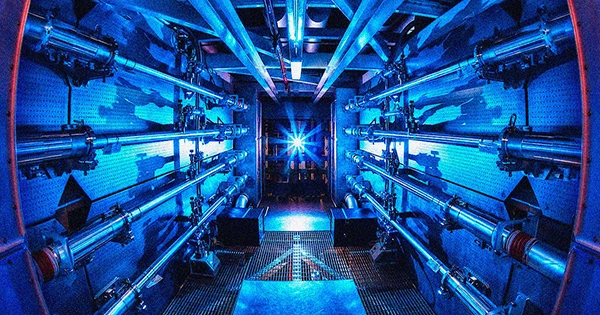With a new record for energy released, a new milestone has been reached in the search for fusion power. While the announcement represents a step toward the aim of powering the planet using the same energy source as the stars, it also serves as a reminder of how far we still have to go. According to fusion reactor models, the best fuel will be a mix of tritium and deuterium. Tritium is a hydrogen isotope with one proton and two neutrons. Surprisingly, practically all fusion research has been conducted using regular hydrogen or deuterium.
But, for the first time since 1997, fusion experiments utilizing tritium have created a record amount of energy for a fusion reactor in a five-second period — 59 megajoules. A press conference was held today to discuss the findings. When tritium is predicted to be a critical component of the ultimate fuel, it may seem nonsensical to conduct practically all of our fusion research with lighter isotopes. In a statement, Dr. Athina Kappatou of the Max Planck Institute for Plasma Physics noted, “We can examine the physics in fusion plasmas extremely effectively by working with hydrogen or deuterium.”
Although Fukushima has more tritium than it needs, tritium is expensive to create, store, and manage, therefore most research facilities choose to employ the less difficult isotopes. Indeed, the Joint European Torus (JET) near Oxford is the only fusion research facility that currently uses tritium, despite having spent decades experimenting with various fuels.
When the International Thermonuclear Experimental Reactor (ITER) commences operations, all of this is projected to alter. Fusion supporters anticipate that ITER will finally fulfill the long-awaited goal of producing far more energy than it consumes to run, allowing commercial operations to begin, though many remain unconvinced. Despite the fact that ITER’s output power is expected to be ten times its official input, this does not take into account requirements such as the energy necessary to construct the plant. Even after accounting for this, it will still be a net energy sink. JET is too tiny to create even the temporary net energy that is ITER’s primary purpose, but it can serve as a test site, providing experience with tritium fuels to the team that will operate ITER when operations begin.
“It’s critical for the transition to…ITER that we prepare for the conditions that will exist there,” Kappatou added. To make JET more nearly resemble a smaller version of ITER, the carbon lining was replaced with beryllium and the more durable tungsten. While these modifications improved JET’s potential capabilities, they also made plasma control more difficult. Despite this, Kappatou and colleagues were able to obtain a yield of 59 megajoules over a 5-second period. When JET used tritium for the last time 25 years ago, it set a world record for energy discharge of 22 megajoules. It’s also about fifty times the output of a recent nuclear fusion experiment, which released more energy than had ever been applied.
“The record, and more significantly, what we’ve learned about fusion under these conditions and how it confirms our expectations, suggest that we’re on the right track toward a future world powered by fusion energy.” In a statement seen by IFLScience, Professor Tony Donné of EUROfusion said, “If we can maintain fusion for five seconds, we can do it for five minutes, then five hours as we scale up our operations in future machines.”
The energy was ejected in the form of neutrons. Even if it could have been converted to energy at 100% efficiency, its average power production of 11 megawatts would not have been enough to equal the largest model of offshore wind turbine. For decades, fusion has been lauded as the ideal clean energy source, and that may still be the case millennia from now. However, with ITER not expected to start using deuterium/tritium fuel until 2035 and a second demonstration unit needed before its lessons can be commercialized, it’s unlikely to arrive in time to solve the climate catastrophe.
















